Physical Address
304 North Cardinal St.
Dorchester Center, MA 02124
On high-resolution computed tomography (CT), normal intrahepatic bile ducts (IHDs) appear as linear water-density structures accompanying the portal vein branches. Normal IHDs measure less than 3 mm. They appear to be randomly scattered throughout the liver but are confluent toward the hilum. The IHDs from each lobe unite to form the right and left main hepatic ducts, which are located anterior to the portal veins ( Fig. 42-1 ). Periportal lymphedema can mimic a dilated IHD but shows a low-density area completely surrounding the portal vein.
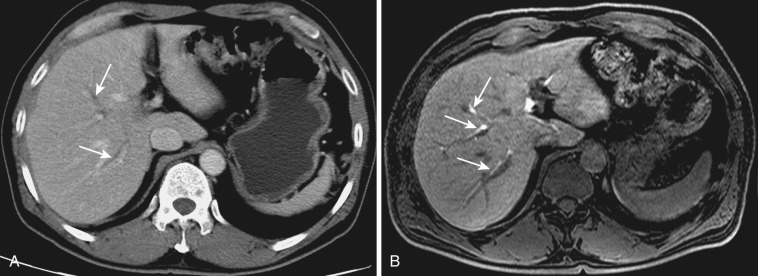
A common anomaly is an aberrant IHD that drains a circumscribed portion of the liver, such as an anterior or posterior segment right lobe duct that drains into the left rather than the right main hepatic duct. Surgical difficulties may arise when the cystic duct enters the right main hepatic duct before joining the left main hepatic duct. The right and left main hepatic ducts unite in the hilum to form the common hepatic duct (CHD). The CHD usually courses along a 45-degree oblique plane with reference to the midline sagittal plane, which lies to the right and lateral to the proper hepatic artery. The right hepatic artery typically branches off the proper hepatic artery and passes between the CHD and the main portal vein in about 80% of subjects.
The common bile duct (CBD) forms when the cystic duct joins the CHD. This union occurs at varying levels, from high in the porta hepatis to near the ampulla of Vater. Because the union is usually not demonstrated on CT, the term common duct is used when the CHD and CBD cannot be differentiated. Duplications of the CBD and cystic duct are rarely observed.
On CT the CHD usually measures 3 to 6 mm in short-axis diameter, and the CBD measures up to 8 mm. The diameter should be measured in the short axis because the duct often courses obliquely through the transverse image. In postcholecystectomy patients and some older adults, the CBD may measure up to 10 mm without obstruction. The wall of the CHD and CBD can normally be demonstrated and measures less than 1.5 mm. The wall may enhance normally and be brighter than the adjacent pancreas on contrast-enhanced CT. The CBD enters the pancreas and typically lies along the posterior and lateral aspect of the pancreatic head. The distal CBD and main pancreatic duct come into contact on the medial side of the descending part of the duodenum. The two ducts pass separately through the wall of the duodenum and unite to form a short dilated tube—the ampulla of Vater. The sphincter of Oddi is the circular muscle complex around the CBD, pancreatic duct, and ampulla of Vater; it consists of the sphincter choledochus, sphincter pancreaticus, and sphincter ampullae. On endoscopic retrograde cholangiopancreatography (ERCP), the ampullary segment is usually not visualized because of the contraction of the sphincter of Oddi ( Fig. 42-2 ). The ampulla of Vater is also responsible for the potential reflux of pancreatic juice into the CBD.
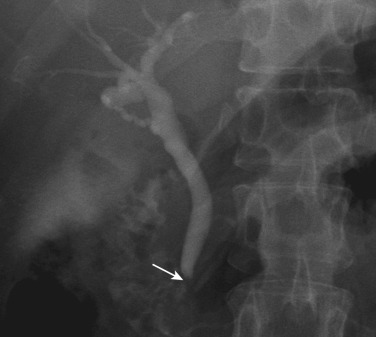
In biliary atresia, ultrasonography (US), CT, and a DISIDA (diisopropyl iminodiacetic acid) scan are the initial imaging studies to evaluate the biliary tree. In more than 10% of patients with biliary atresia, other anomalies are present, such as polysplenia, bilateral bilobed lungs, azygos continuation of the inferior vena cava, intestinal malrotation, and situs inversus. CT can identify the development of cirrhosis, varices, splenomegaly, and ascites and plays an important role in the evaluation of such patients before liver transplantation.
Anomalous pancreaticobiliary ductal junction is an uncommon congenital anomaly in which the main pancreatic duct and CBD are joined outside the duodenal wall and form a long common channel (usually >15 mm). Although this anomaly is found in almost all patients with congenital choledochal cyst, it is also observed in patients without choledochal cyst. Because an anomalous pancreaticobiliary ductal junction is frequently associated with cholangiocarcinoma, early diagnosis is important. ERCP is the most reliable method for detecting anomalous pancreaticobiliary ductal junction, but it is an invasive procedure ( Fig. 42-3A ). Recently magnetic resonance (MR) cholangiopancreatography (MRCP) and multidetector CT (MDCT) with multiplanar reconstruction of images have been used to diagnose this anomaly (see Fig. 42-3B and C ).
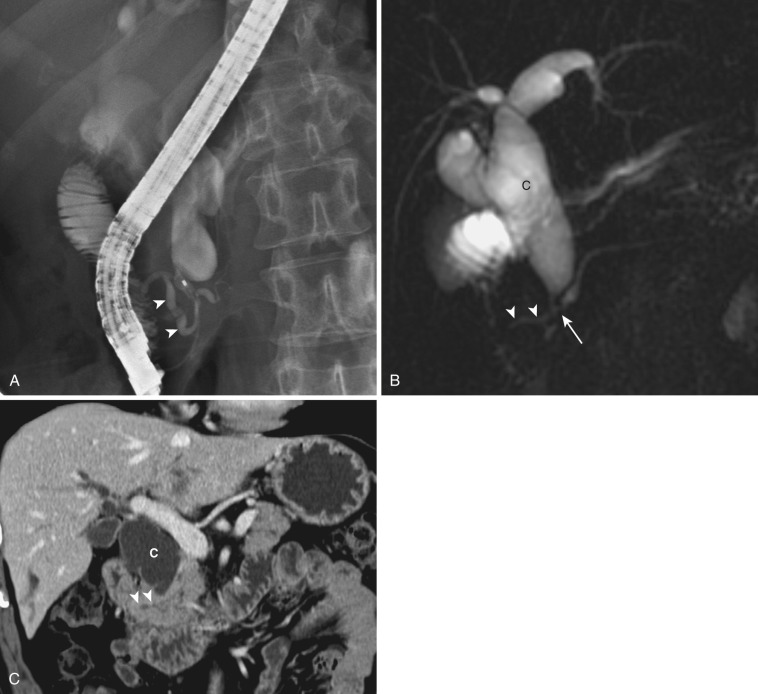
Choledochal cyst involves congenital cystic dilatation of any portion of the extrahepatic bile ducts, most commonly the main portion of the CBD. It is classified based on the spectrum of morphologic changes in the bile ducts. The most common classification scheme is the Todani modification of the Alonso-Lej classification :
Type I: single cystic dilatation of the CBD, CHD, or both (80%-90% of cases) ( Fig. 42-4 )
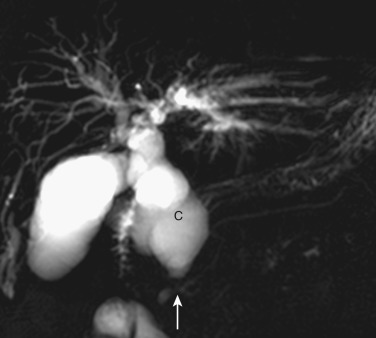
Type II: true diverticulum of the CBD (3%)
Type III: choledochocele (5%)
Type IV: any combination of cysts, which may include intrahepatic cystic dilatation (10%). Type IV-A involves multiple cysts of the common duct and IHDs, and type IV-B involves multiple cysts of the common duct.
Type V: cystic dilatation of only the IHDs—so-called Caroli's disease (rare)
Among these five types, types III and V are not cystic dilatation of the CBD and thus are not considered true choledochal cysts.
The cause of this condition is not clear, but it may be multifactorial. It has been suggested that choledochal cyst, biliary atresia, and neonatal hepatitis are part of the same spectrum of disease. This condition is also associated with an increased incidence of gallbladder anomalies and congenital hepatic fibrosis. It may result from an anomalous pancreaticobiliary ductal junction, with free reflux of pancreatic enzymes into the CBD.
Choledochal cysts are more common in females. Although they can present from birth to old age, about 60% of choledochal cysts are found before adolescence. Newborns and infants present with obstructive jaundice; older children and adults may have right upper quadrant pain, mass, and intermittent jaundice. The diagnosis is easily made by detecting cystic dilatation of the bile duct on cross-sectional imaging. CT and magnetic resonance imaging (MRI) can make the diagnosis if direct communication with the cyst and the biliary tree is demonstrated (see Figs. 42-3 and 42-4 ). Cholangiography can confirm the diagnosis. Mild secondary dilatation of IHDs, stones, or sludge may be found as well ( Fig. 42-5 ).
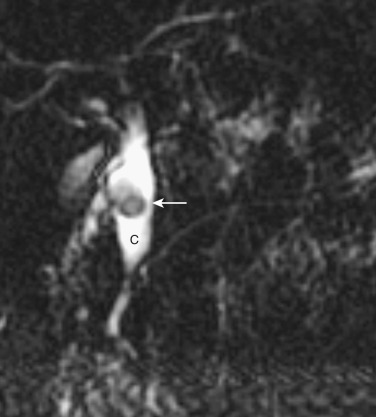
Complications of choledochal cysts in adults include rupture with bile peritonitis, stone formation, cholangitis, hemorrhage, portal vein thrombosis, biliary cirrhosis, liver abscess, pancreatitis, and cholangiocarcinoma. An increased incidence (4%-28%) of malignancy involving the hepatobiliary system has been reported in patients with choledochal cysts, compared with normal subjects. Malignancy developing in patients with choledochal cyst may be caused by chronic mucosal irritation; it usually occurs in the choledochal cyst but can develop anywhere in the biliary tree, including the gallbladder ( Fig. 42-6 ). Cholangiocarcinoma arising in a choledochal cyst appears as a soft tissue–density mass or irregular thickening of the cyst wall. The principal management of choledochal cysts is surgery, with excision of all cyst tissue and reconstruction of continuity between the liver and the gut.
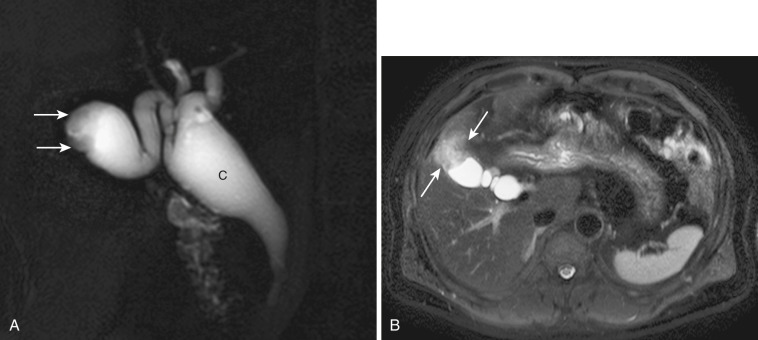
Choledochocele is a rare anatomic anomaly of unknown cause. It is a protrusion of a dilated intramural segment of the distal CBD into the duodenum, analogous to a ureterocele. On CT a round water-density structure is found in or medial to the pancreatic head or occasionally within the lumen of the duodenum. Differential diagnostic considerations include an intraluminal duodenal diverticulum, small pseudocyst, duodenal duplication cyst, or small cystic neoplasm of the pancreas. Cholangiography shows smooth saccular dilatation of the intramural segment of the CBD ( Fig. 42-7 ). Stones and sludge are common, and patients sometimes have episodes of biliary colic, intermittent jaundice, and pancreatitis as well.
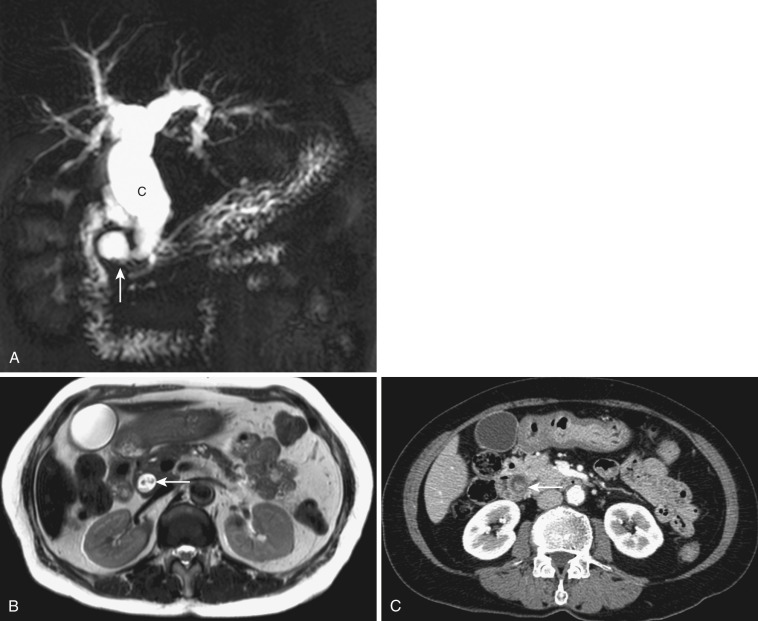
Caroli's disease is also known as communicating cavernous ectasia of the IHDs. The uncommon pure form of this entity involves congenital saccular dilatation of only the IHDs. The more common classic form consists of saccular dilatation of the IHDs with congenital hepatic fibrosis. The common association of congenital CBD dilatation suggests that Caroli's disease may be part of the spectrum of choledochal cyst. In addition this disease is frequently associated with renal tubular ectasia and other renal cystic disease. Clinically Caroli's disease usually manifests in adulthood; however, it can be observed in newborns and infants. Adult patients generally present with recurrent attacks of cholangitis. Infants and children may present with hematemesis caused by hepatic fibrosis and portal hypertension.
On CT the saccular dilatation of the IHDs may mimic multiple hepatic cysts. The cystic areas of Caroli's disease can be shown to communicate directly with the IHDs. The distribution of cystic dilatation is often segmental ( Fig. 42-8 ). CT may also show tiny dots with strong contrast enhancement within dilated IHDs—the so-called central dot sign. These dots represent the enhancing portal veins. Caroli's disease is best demonstrated by cholangiography, which shows saccular dilatations of the IHDs.
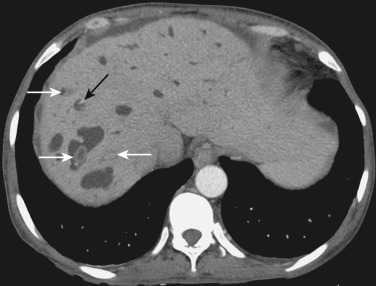
Complications of Caroli's disease include stone formation, cholangitis, hepatic abscess, hepatic amyloidosis, pancreatitis, and biliary malignancy.
Stones in the extrahepatic duct may originate from the gallbladder or primarily from within the bile ducts. Primary stones are formed primarily in the extrahepatic bile ducts. Clearly, stones in the extrahepatic ducts in patients with cholecystectomy or congenital absence of the gallbladder are primary. Extrahepatic duct stones that originate in the gallbladder and later pass through the cystic duct into the CBD are called secondary stones .
In Western countries, stones in the CBD are composed of cholesterol in about 80% of cases and calcium bilirubinate in 20%. Cholesterol stones arise exclusively in the gallbladder; these stones contain more than 50% crystalline cholesterol monohydrate. Calcium bilirubinate stones are composed predominantly of bilirubin calcium salt; these fragile stones are also called pigment stones. About 95% of patients with choledocholithiasis in Western countries also have gallbladder stones ( Fig. 42-9 ); when they do not, the gallbladder may show acute or chronic inflammatory changes, suggesting that it previously contained stones ( Fig. 42-10 ).
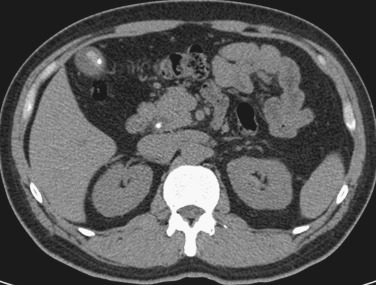
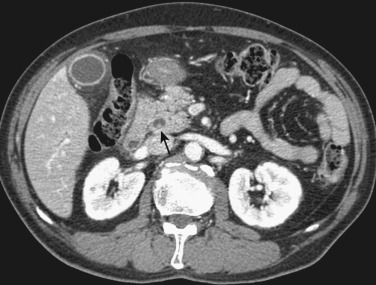
In Asia, pigment stones account for more than 50% of stones, and they are formed primarily in the bile ducts ( Fig. 42-11 ). Unlike cholesterol stones, pigment stones can crumble or crush easily. Some stones are very friable or muddy, like earth, floating in the bile as debris. The formation of pigment stones is related to a high prevalence of recurrent pyogenic cholangitis. Infection of the biliary tract, such as with Escherichia coli, Clonorchis sinensis, Opisthorchis viverrini, or Ascaris lumbricoides, increases the likelihood of pigment stone formation by increasing the concentration of insoluble calcium salts of unconjugated bilirubin.
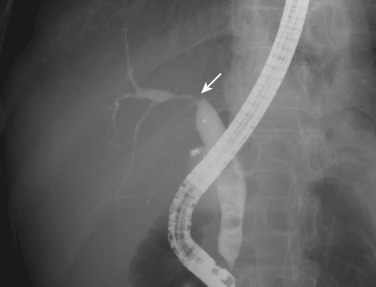
Intrahepatic biliary stones, which are formed primarily within the IHDs, are rare in Western countries. These stones occur in patients with underlying biliary anomalies such as Caroli's disease, biliary atresia, or cystic fibrosis or previous biliary surgery. In some parts of Asia, intrahepatic stones are common in patients with recurrent pyogenic cholangitis. The stones are found mostly in the large-caliber ducts, such as the left hepatic lobe ( Fig. 42-12 ) or the posterior segment of the right hepatic lobe. The stones migrate downward to the CBD or reside in the liver when there is a stricture. The bile duct wall shows chronic proliferative cholangitis, suppurative cholangitis, and chronic granulomatous cholangitis, resulting in severe fibrosis and inflammatory cell infiltration.
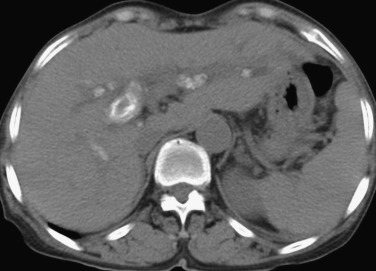
The natural history of choledocholithiasis is unpredictable. Small stones may pass spontaneously into the duodenum without causing symptoms. Clinical and autopsy series suggest that nearly half of stones do not produce clinical manifestations such as cholangitis or jaundice. Spontaneous resolution of jaundice occurs as the stones pass through the duodenal papilla or if the stones float back up to the proximal bile duct away from the narrow distal end. Passage of a large stone through the narrow duodenal papilla can induce papillitis or papillary stenosis and incomplete bile duct obstruction ( Fig. 42-13 ).
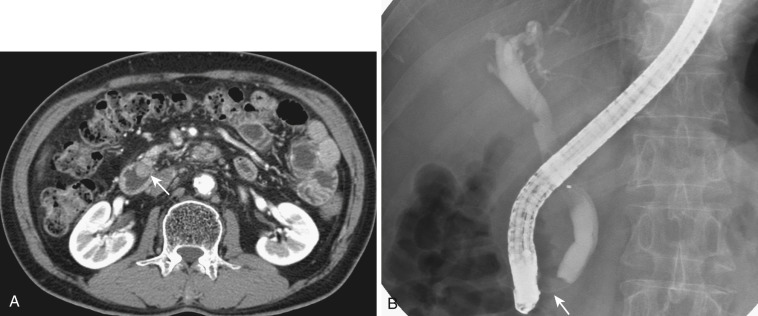
Stones that do not pass and reside in the bile duct may induce obstructive jaundice and cholangitis or pancreatitis ( Fig. 42-14 ). When a stone obstructs the bile duct in the absence of infected bile, asymptomatic fluctuating jaundice often ensues. When a stone obstructs the CBD and the bile becomes infected, acute suppurative cholangitis ensues ( Fig. 42-15 ). The classic triad of symptoms is fever with chills, pain, and jaundice.
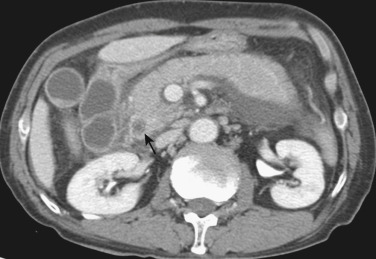
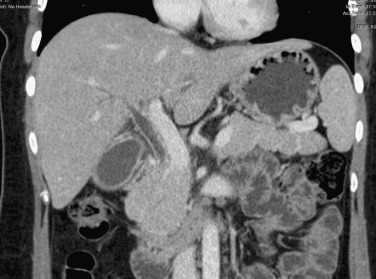
In patients with recurrent pyogenic cholangitis, stones are continually formed in the bile ducts and repeatedly pass through the ampulla of Vater and duodenal papillary orifice; this can cause papillary stenosis, presenting with recurrent bile duct obstruction and cholangitis. Typically patients experience one or two attacks of acute suppurative cholangitis a year.
The detectability of a bile duct stone on CT depends on the calcium content. Although many stones are cholesterol stones, some have sufficient bilirubinate and calcium to exhibit high attenuation on CT images ( Fig. 42-16 ). About 20% of stones are homogeneously calcified and easily seen; in others the calcium content is variable. Depending on the composition, stones may show soft tissue attenuation, near-water attenuation, or fat or air attenuation, with peripheral calcification around the stone. Precontrast CT is necessary to visualize calcified stones because postcontrast CT masks them ( Fig. 42-17 ). Some stones with mixed composition are isoattenuating to bile or adjacent soft tissue and are therefore difficult to detect on CT ( Fig. 42-18 ). Pure cholesterol stones are rare but exhibit low attenuation resembling that of soft tissue ( Fig. 42-19 ) or bile ( Fig. 42-20 ). Stones containing fat or air can be detected because of the difference in attenuation from bile ( Fig. 42-21 ).
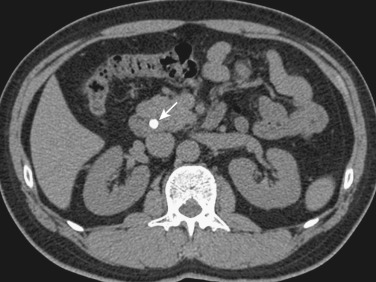
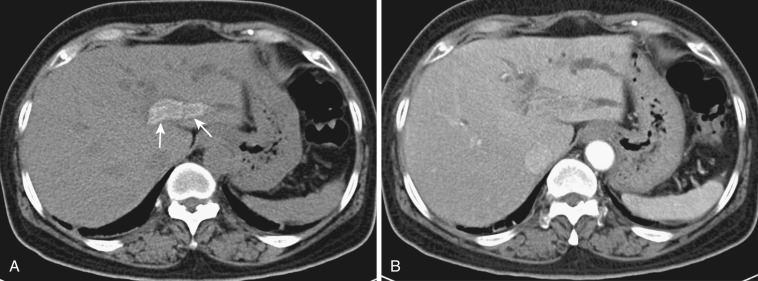
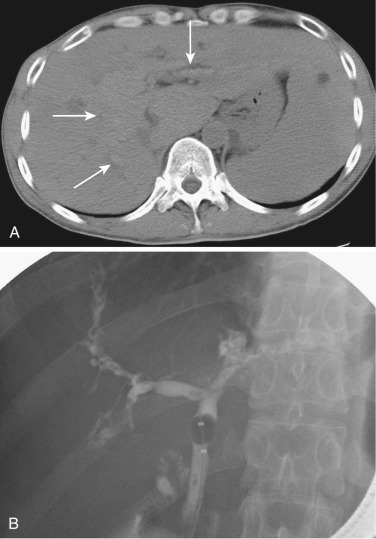
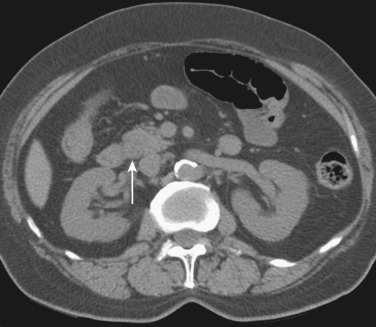
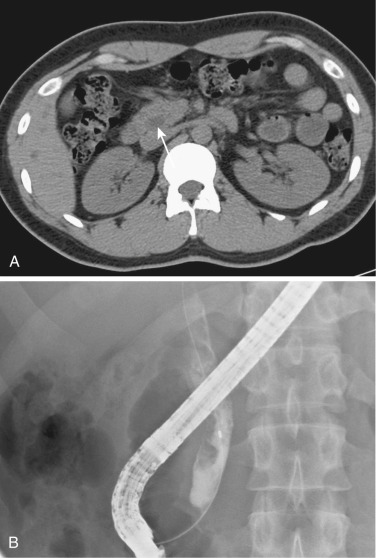
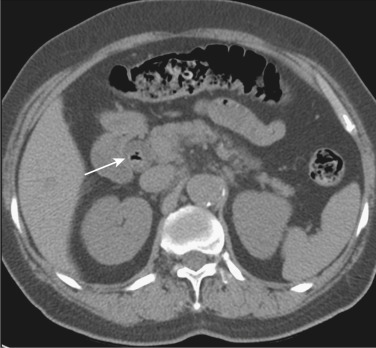
For more accurate detection of intrahepatic ductal stones, thin section with narrow collimation (<2.5 mm) is necessary. The presence of bile around a stone results in a ring (bull's-eye or target sign) or a crescent of water attenuation between the stone and the bile duct wall ( Fig. 42-22 ). A concentrically thickened bile duct wall with enhancement may be seen around a stone, representing inflammation and fibrosis due to irritation by the stone. On cholangiograms or MR cholangiograms, stones are depicted as single or multiple filling defects ( Fig. 42-23 ). Muddy stones, small fragments of stones, and gravel are difficult to visualize on CT (see Fig. 42-20 ), MR, or even cholangiography.
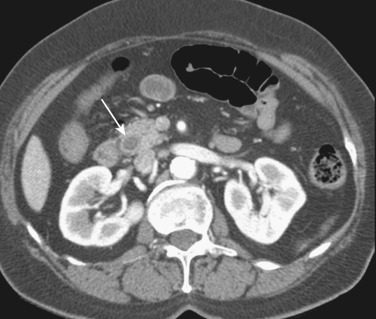
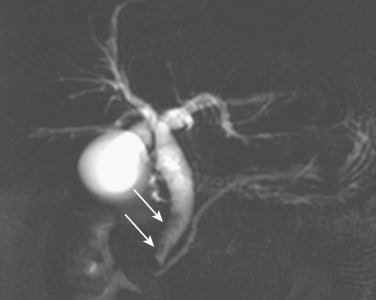
Bile ducts may not be dilated despite the presence of stones in the common duct in 24% to 36% of cases ( Fig. 42-24 ). In acute obstruction due to stone impaction, the bile duct does not become dilated until some time has passed. Bile ducts remain dilated after passage of a stone through the papilla of Vater because the duodenal papillary orifice becomes tight owing to papillitis and papillary edema (see Fig. 42-13 ).
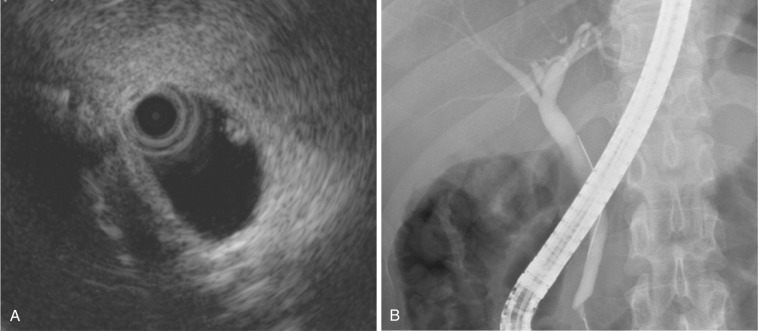
Small stones and gravel repeatedly passing through the duodenal papillary orifice can cause papillitis and eventually papillary stenosis. CT or MRI demonstrates a dilated and thickened bile duct and an enlarged duodenal papilla (see Fig. 42-13 ) but no actual stone in the bile duct.
The ability to detect a biliary stone by imaging varies depending on the size, location, and components of the stone. Each modality has advantages and disadvantages. With CT, detection depends on the stone's calcium content and bile duct dilatation. Detection of stones by MRI is hampered by artifacts caused by pulsation of the adjacent vessels. During cholangiography, the technique of cannulation and bile duct opacification must be optimal for visualization of small stones.
Sometimes a stone that is not detected by one imaging modality is demonstrated by another ( Fig. 42-25 ; see Fig. 42-24 ). Thus two or more imaging methods may be necessary for the diagnosis of bile duct stones.
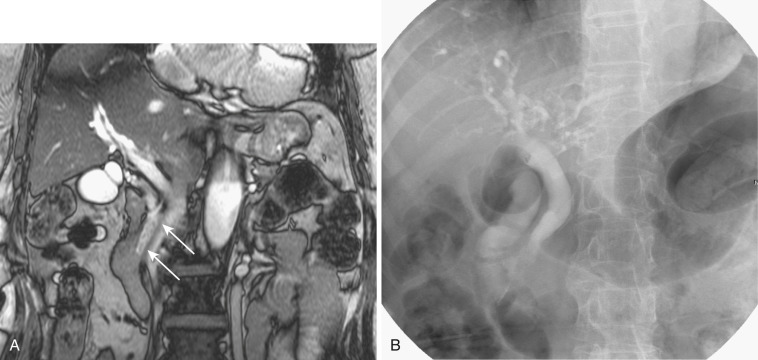
Acute suppurative cholangitis is a bacterial infection of the bile ducts occurring mostly in patients with biliary obstruction caused by either stones or a tumor. Most stones originate from the gallbladder ( Fig. 42-26 ). The tumor may be a carcinoma of the bile ducts, head of the pancreas, or ampulla of Vater or (uncommonly) a benign tumor.
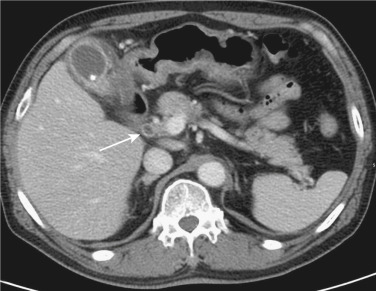
The bile ducts may be normal or dilated, depending on the cause, duration, and degree of obstruction. In acute obstruction caused by a stone, the bile ducts may not be dilated for some time, whereas in obstruction caused by cancer, the bile ducts are usually dilated. Obstruction of the bile ducts causes bile stasis and a predisposition to infection. Gram-negative organisms such as E. coli are usually responsible. It is believed that bacteria within the intestinal tract ascend through the ampulla of Vater; for this reason the disease is also called ascending cholangitis. Bacterial colonization may also occur through portal venous bacteremia. The combination of obstruction and colonization leads to cholangitis, but neither obstruction nor colonization by itself is sufficient to cause disease. Patients present with acute abdominal pain, fever, chills, and sometimes jaundice. In some patients with bile duct stones or carcinoma along the bile ducts, the initial symptoms and signs may be similar to those of acute suppurative cholangitis.
Other than bile duct dilatation, imaging finding are usually normal. The presence of purulent bile may result in increased attenuation of bile (greater than that of water) on CT, but it is usually not clearly depicted. Depending on the calcium content, stones may be clearly depicted as calcified high-attenuating foci or as noncalcified intraluminal material (see Figs. 42-19 and 42-20 ).
The wall of the bile ducts may be thickened concentrically and diffusely, with dense contrast enhancement ( Fig. 42-27 ; see Fig. 42-26 ); this is well delineated with thin-section CT. In contrast to periductal-infiltrating bile duct cancer, the thickness of the bile ducts is uniform and less than 1 mm. In patients with suppurative cholangitis caused by a cancer along the bile ducts, a nodular mass or periductal-infiltrating cholangiocarcinoma is depicted on US, CT ( Fig. 42-28 ), and MRI.
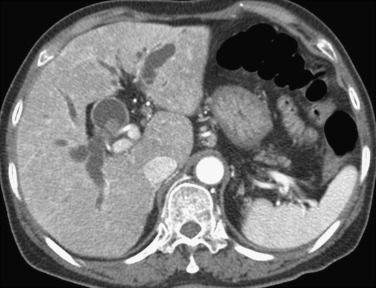
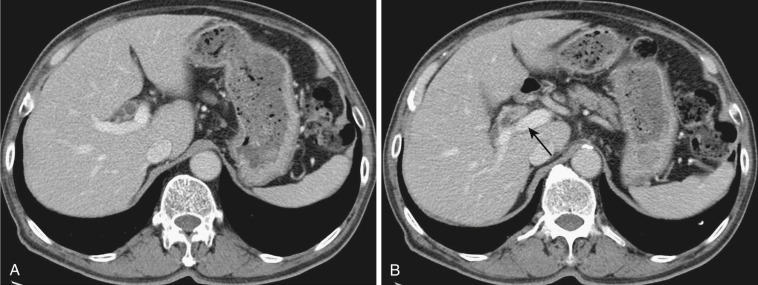
One complication of suppurative cholangitis is the occurrence of multiple intrahepatic abscesses, and there may be communication with the biliary tree. In a fulminating infection of gas-forming organisms, pneumobilia can be seen on CT.
Recurrent pyogenic cholangitis, also known as Oriental cholangitis, Oriental cholangiohepatitis, or intrahepatic pigment stone disease, is characterized by recurrent attacks of acute bacterial cholangitis presenting with abdominal pain, fever, chills, and jaundice. A bile duct stone is an integral part of the disease, and the symptom complex repeats once or twice a year. The disease is prevalent in the Far East and Southeast Asia (thus its alternative names); it occurs infrequently in non-Asians.
The stones in patients with recurrent pyogenic cholangitis are mainly bilirubinate pigment stones formed in the bile ducts, whereas the most common stones in Caucasian people are cholesterol stones in the CBD that originated from the gallbladder. Many patients with recurrent pyogenic cholangitis also have muddy stones or tiny gravel.
Chronic infection of the biliary tree by C. sinensis or O. viverrini or inadvertent biliary Ascaris infection is a possible cause of the disease. A long-standing partial obstruction due to parasites in the bile ducts, bile stasis, increased secretion of mucin, or eggs or excreta of parasites predisposes the patient to form bile duct stones, with the eggs or debris being the stone's nidus. Alternatively, portal septicemia due to poor eating habits and poor nutrition has been proposed as a cause of bile duct infection and stone formation.
Because of repeated inflammation, the bile duct walls are thickened diffusely owing to inflammatory cell infiltration and fibrosis. Fibrosis causes the bile ducts to become rigid and straight, lacking gentle dichotomous branching ( Fig. 42-29 ). In severe infection, adjacent hepatic parenchyma is involved, resulting in cholangiohepatitis. Sometimes this inflammation becomes suppurative and the bile ducts fill with pus. Larger IHDs and extrahepatic ducts become dilated because of a stricture of the duodenal papilla caused by mechanical irritation and inflammation due to the repeated passage of stones or sharp gravel. However, the small IHDs are not dilated because of ductal fibrosis. Thus the biliary tree has a “pruned tree” appearance because of the notable dilatation of the larger bile ducts, decreased arborization, and nonvisualization of the peripheral branches ( Fig. 42-30 ; see Fig. 42-29 ). Owing to long-standing inflammation and fibrosis, peripheral bile ducts appear rigid and taper abruptly, producing an “arrowhead” appearance (see Fig. 42-29 ).
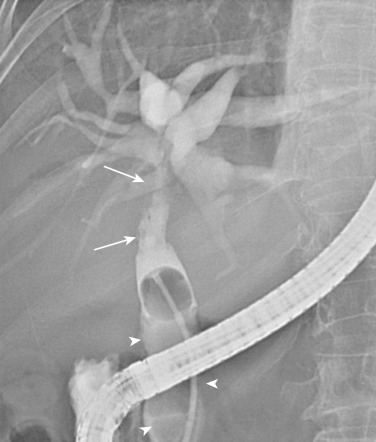
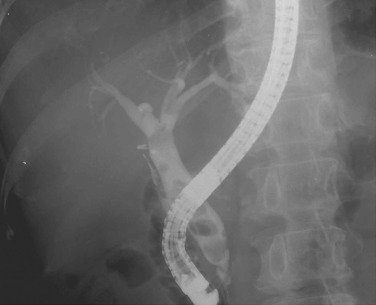
Imaging findings include stones, a dilated bile duct, wall thickening, and duodenal papillary stenosis. Stones are visualized in 70% to 80% of patients in the intrahepatic or extrahepatic ducts or both (see Fig. 42-30 ). For patients with intrahepatic stones, the lateral segment of the left hepatic lobe and posterior segment of the right hepatic lobe are frequent sites of stone lodging.
The characteristic bile duct involvement patterns persist even when the stone passes into the duodenum. This is true because repeated passage of stones causes papillitis, fibrosis, and papillary stenosis.
In some cases, bile duct dilatation is limited to the hepatic segmental or lobar bile ducts. This dilatation occurs as intrahepatic stones lodge at the branching points of large-caliber bile ducts, causing mechanical irritation, chronic inflammation, and fibrosis and a resultant stricture ( Fig. 42-31 ). Frequent sites of focal stricture are the branching points of the medial and lateral segments of the left hepatic lobe ( Fig. 42-32 ), posterior segmental duct of the right hepatic lobe, and bifurcation of the right and left hepatic lobes (see Fig. 42-29 ).
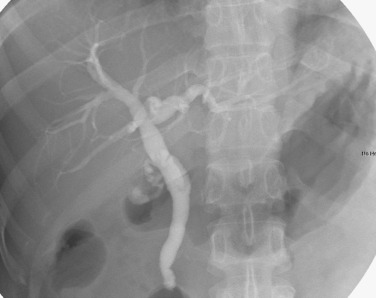
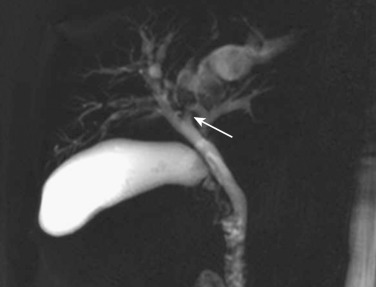
With acute and chronic inflammation, the wall of the bile duct becomes thickened. On high-resolution contrast CT, the thickened wall is clearly visualized and enhanced ( Fig. 42-33 ). The thickening of the bile duct in patients with recurrent pyogenic cholangitis is more severe than in those with acute suppurative cholangitis but less severe than in patients with periductal-infiltrating cholangiocarcinoma.
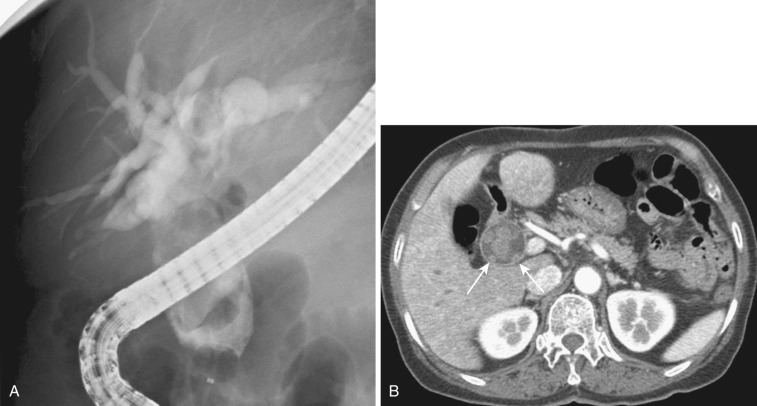
During the stage of acute exacerbation, the periductal hepatic parenchyma is enhanced on contrast-enhanced CT, reflecting periductal hepatic parenchymal inflammation (cholangiohepatitis) ( Fig. 42-34 ). Sometimes the hepatic lobe or segments are enhanced in the arterial phase, probably owing to severe cholangiohepatitis and arterial hyperemia. Hepatic abscesses occur as a complication ( Fig. 42-35 ). In patients with stricture of the lobar or segmental bile ducts, the corresponding hepatic lobe or segment becomes atrophic because of long-standing obstruction of the bile ducts. Periportal inflammation and portal venous encroachment may play an additional role.
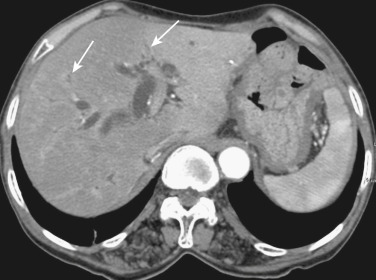
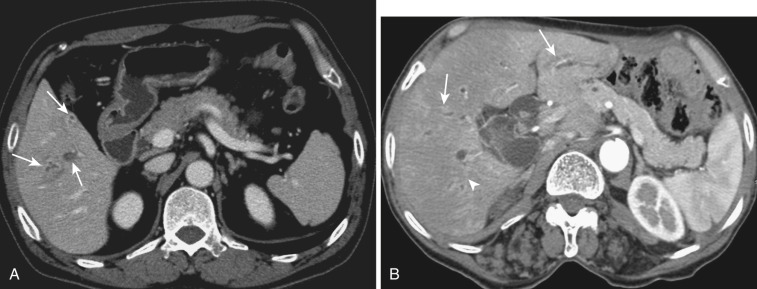
Duodenal papillitis and papillary stenosis are an integral part of recurrent pyogenic cholangitis. Impaction of stones and repeated passage of small stones or sharp gravel through the papillary orifice cause irritation, inflammation, edema, fibrosis, and a resultant papillary stricture.
A swollen duodenal papilla can be demonstrated on CT ( Fig. 42-36 ) and MR cholangiography. Papillary stenosis is difficult to demonstrate on sonography, CT, cholangiography, and MR cholangiography because the structure of the ampulla-papilla is small, and papillary stenosis caused by fibrosis cannot be visualized on imaging ( Fig. 42-37 ).
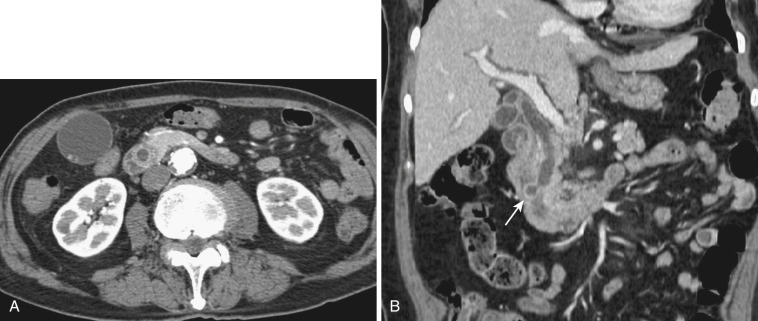
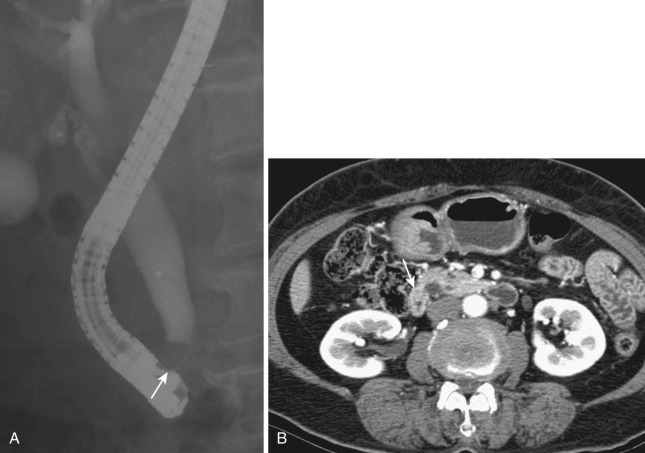
Biliary cirrhosis is a possible complication and usually follows long-standing severe, repeated disease. Stones at the lower end of the CBD may cause acute pancreatitis and a choledochoduodenal fistula. Intrahepatic cholangiocarcinoma may develop in a stone-harboring bile duct because of long-standing inflammation, hyperplasia, and dysplasia. The reported prevalence ranges from 1.5% to 11%.
Primary sclerosing cholangitis (PSC) is a chronic cholestatic liver disease of unknown cause characterized by diffuse inflammation and fibrosis of the biliary tree. PSC is a progressive disease that can lead to obliteration of the bile ducts and subsequently biliary cirrhosis; it may eventually progress to end-stage liver disease and cholangiocarcinoma. Liver transplantation is the only effective life-extending treatment for advanced PSC. The disease is much more common in northern Europe and the United States than elsewhere, with the age-adjusted incidence in the United States being 1.25 per 100,000 men and 0.54 per 100,000 women ; it is exceedingly rare in Asian populations. Approximately 70% of the patients are male, and 70% have ulcerative colitis.
The pathology of sclerosing cholangitis is characterized by a fibrosing inflammation of the biliary tree resulting in diffuse thickening of the bile duct wall, which if severe enough leads to obstruction of the lumen. There are alternating areas of focal narrowing and ductal dilatation. On microscopic examination there is dense fibrosis, sparse mixed inflammatory cell infiltration, and a relatively intact epithelium. These findings are nonspecific, and the diagnosis cannot be based solely on a biopsy specimen. Because of periductal fibrosis, ductal dilatation is not prominent even with high-degree obstruction. PSC involves the intrahepatic and extrahepatic ducts. In 20% of patients, the disease is confined to the intrahepatic and hilar ducts. The gallbladder is involved in 40% of patients.
Cholangiogram has long been the gold standard for the diagnosis of PSC. Multiple segmental strictures involving the intra- and extrahepatic bile ducts are hallmarks of the disease and characteristic findings ( Fig. 42-38 ). The abnormality is not uniform along the bile ducts. A normal or less-involved segment alternating with strictures produces the classic “beaded” appearance ( Fig. 42-39 ). The length of a stricture can range from 1 to 2 mm to several centimeters. When the peripheral bile ducts are obliterated, the bile ducts have a pruned-tree appearance (see Fig. 42-38 ). The bile duct wall is irregular, from a fine brush border to a coarse, shaggy, or nodular appearance (see Fig. 42-39 ). Sometimes there are small diverticula. Thus the combination of short focal strictures and dilatations, beading, pruning, and mural irregularities are typical for PSC.
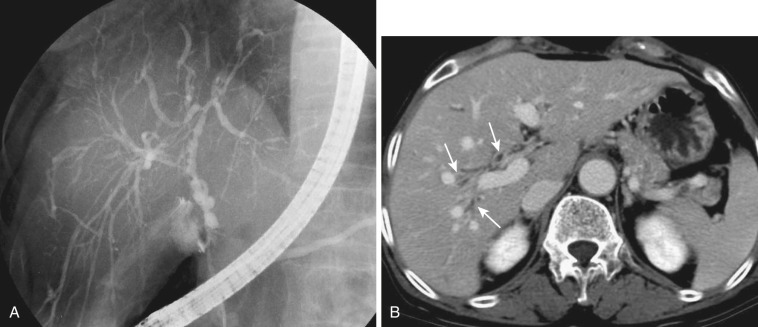
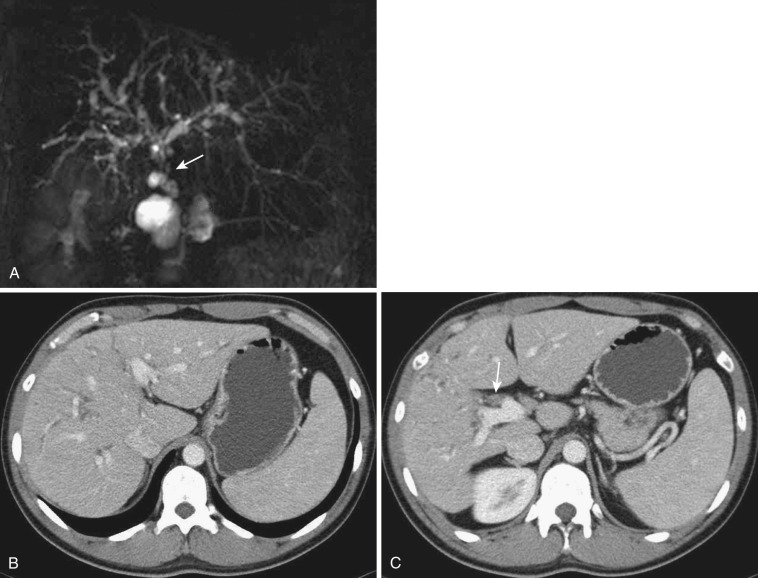
MRCP has merit in depicting bile duct involvement patterns of alternating strictures and dilatations of the entire biliary tree (see Fig. 42-39 ). In addition to the advantage of noninvasiveness, MR cholangiography can demonstrate abnormal bile ducts proximal to the completely obstructed segment that cannot be demonstrated by cholangiography.
Sonography and contrast-enhanced CT and MRI may show thickening ( Fig. 42-40 ) and contrast enhancement ( Fig. 42-41 ) of the bile duct wall. The thickness varies from 1 to 3 mm. Thus these imaging techniques are helpful to determine the severity and extent of disease. In some instances, cholangiographic “beading” can be seen on contrast-enhanced CT (see Fig. 42-39 ). Like MRCP, CT has the advantage of being able to visualize an obstructed segment that cannot be demonstrated on cholangiography.
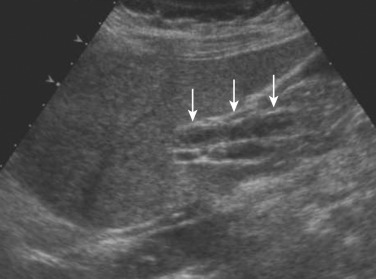
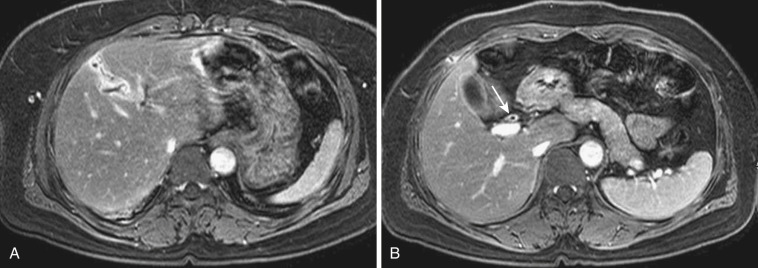
Other imaging findings include alterations of the hepatic parenchyma such as biliary cirrhosis, hepatic segmental atrophy and hypertrophy, portal hypertension, a dominant biliary stricture resulting in obstructive jaundice, calculi in the gallbladder and CBD (25%-30%), and a complicating cholangiocarcinoma (8%-15%).
There is an increased incidence of cholangiocarcinoma in patients with PSC. In a series of patients undergoing liver transplantation for PSC, 10% were found to have cholangiocarcinoma in their native livers. When the two diseases coexist, the ductal abnormality of PSC can easily mask the presence of cholangiocarcinoma. Cholangiocarcinoma usually causes more complete obstruction than PSC (dominant stricture), and there may be markedly dilated bile ducts proximal to the bile duct segment involved by the cholangiocarcinoma. A rapidly progressing segmental stricture and proximal dilatation on serial images associated with clinical deterioration favor the presence of cholangiocarcinoma. In this regard, thin-section CT and MRI are helpful to assess the clinical course.
Inflammation of the bile ducts can occur in patients with acquired immunodeficiency syndrome (AIDS), owing to an opportunistic infection by cytomegalovirus, Mycobacterium avium-intracellulare, Candida albicans, Cryptosporidium species, and Klebsiella pneumoniae . Inflammation may involve the intrahepatic and extrahepatic ducts as well as the duodenal papillae, resulting in papillary stenosis. Cholangiogram shows irregularities and stricture of the intrahepatic and extrahepatic bile ducts with associated bile duct dilatation. Papillary stenosis often occurs in conjunction with proximal duct stricture. Tiny polypoid intraductal defects due to granulation tissue can also be observed. CT and sonography may demonstrate wall thickening of the bile duct and gallbladder. A small nodule may be seen at the distal end of the CBD, reflecting inflammation and edema of the papilla of Vater.
Biliary parasitic diseases include clonorchiasis, opisthorchiasis, fascioliasis, and ascariasis. These diseases are prevalent in East and Southeast Asia but rare in the United States and Western Europe. C. sinensis and O. viverrini are human liver flukes acquired through ingestion of raw freshwater fish harboring metacercariae; Fasciola hepatica is a sheep liver fluke and humans are infected accidentally. Adult flukes live in the bile ducts and produce a mechanical obstruction, mucosal inflammation, adenomatous hyperplasia, and periductal fibrosis ( Fig. 42-42 ).
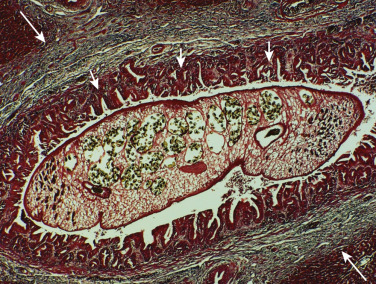
Infection with C. sinensis and O. viverrini produces diffuse and uniform dilatation of the peripheral IHD, with no or minimal dilatation of the extrahepatic ducts and without a focal obstructing lesion along the bile ducts ( Fig. 42-43 ). This occurs because the flukes reside in the small IHDs. This characteristic pattern of the biliary tree—apparent on cholangiography, CT, and MR cholangiography—is not encountered in other bile duct diseases such as cholangitis, bile duct stone, or tumor. Adult flukes in the bile ducts can be demonstrated on cholangiography ( Fig. 42-44 ) and MR cholangiography ( Fig. 42-45 ) as small, linear, elliptical or leaflike filling defects measuring 2 to 10 mm long. The worms and their aggregates in the bile duct lumen, in association with the inflammatory reaction, impede contrast opacification of the peripheral ducts (see Fig. 42-44 ).
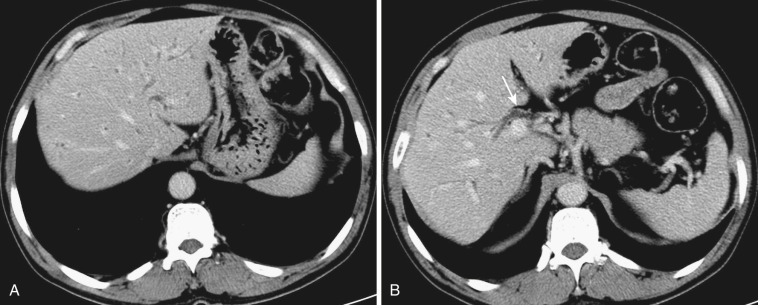
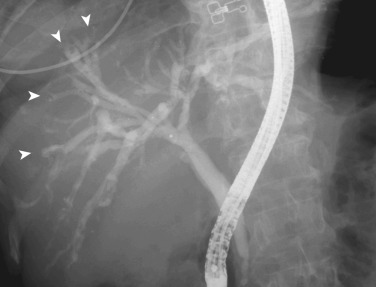
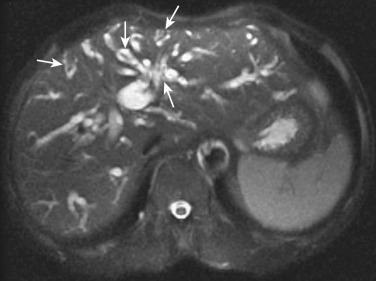
Because of long-standing inflammation and fibrosis, the bile duct wall is thickened. CT may show the enhancing wall of the bile ducts. The gallbladder may be distended. In heavy infection the branch ducts of the tail of the pancreas are dilated, as in the liver.
Once infection occurs the flukes can live in the biliary tree for decades. Peripheral intrahepatic dilatation persists for a long time, even after the flukes are eradicated spontaneously or by the administration of anthelmintic drugs. Recurrent pyogenic cholangitis and bile duct stone formation are frequent complications of clonorchiasis. Intraductal inflammation, increased mucin, and mechanical obstruction by the flukes and their eggs cause bile stasis, which provides a favorable environment for bacterial infection. The eggs and bacteria serve as nidi for pigment stone formation. A carcinoma may arise from the intrahepatic and extrahepatic bile ducts as a complication of long-standing fluke infection ( Figs. 42-46 and 42-47 ). Chronic inflammatory changes and adenomatous hyperplasia of the biliary mucosal epithelium may transform into dysplasia and cholangiocarcinoma.
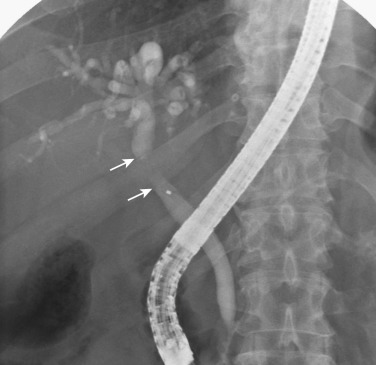
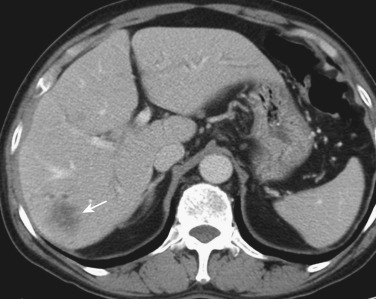
F. hepatica is a trematode that infects cattle and sheep; humans are accidental hosts. Infection is caused by ingestion of raw aquatic plants contaminated with metacercariae, which later penetrate the intestinal wall and migrate through the peritoneal cavity to the liver. After penetrating Glisson's capsule, the flukes migrate randomly through the liver parenchyma (hepatic stage) and enter the bile ducts, where they mature and release eggs (biliary stage). Hepatic fascioliasis manifests as clusters of microabscesses, usually in the subcapsular regions, arranged in a characteristic serpentine fashion resembling “tunnels and caves” ( Fig. 42-48 ). A large cystlike necrotic lesion may also be observed. Imaging findings of biliary fascioliasis are more or less the same as for clonorchiasis, with bile duct dilatation and intraductal flukes appearing as echogenic foci on ultrasonograms and as filling defects on cholangiograms ( Fig. 42-49 ) and MR cholangiograms.
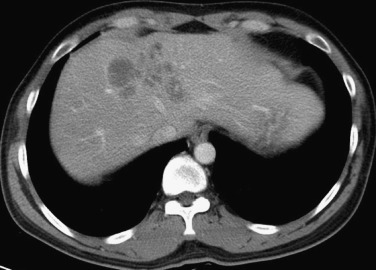
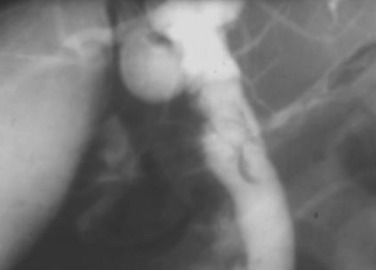
The intestinal roundworm Ascaris lumbricoides is 15 to 30 cm long and 3 to 5 mm thick and resides in the human small intestine. Occasionally worms migrate through the papilla of Vater into the biliary tree, resulting in bile duct obstruction, cholangitis, and pancreatitis. The long worm is seen as a filling defect on cholangiograms or MR cholangiograms ( Fig. 42-50 ).
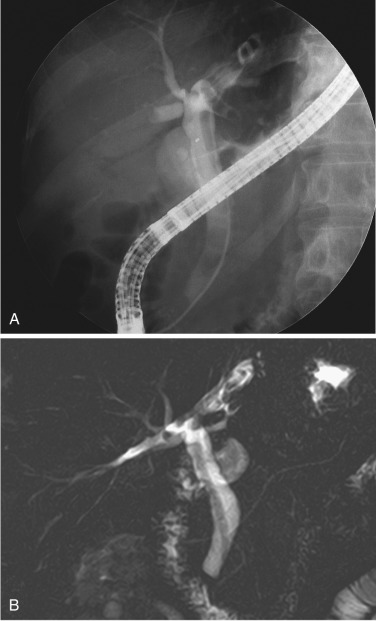
A benign bile duct stricture may affect the intrahepatic or extrahepatic ducts or both. Common causes of benign strictures are inflammatory and iatrogenic. PSC and recurrent pyogenic cholangitis are the most common causes of an inflammatory stricture. An iatrogenic bile duct injury is most often caused by surgery such as a cholecystectomy, CBD exploration, T-tube indwelling in the CBD, endoscopic papillotomy, or liver transplantation. A laparoscopic cholecystectomy predisposes to bile duct injury because the CBD may be mistaken for the cystic duct. Thermal injury to the bile duct can occur during radiofrequency ablation for hepatic tumors ( Fig. 42-51 ). Blunt abdominal trauma may result in injury to the duodenum and extrahepatic bile ducts.
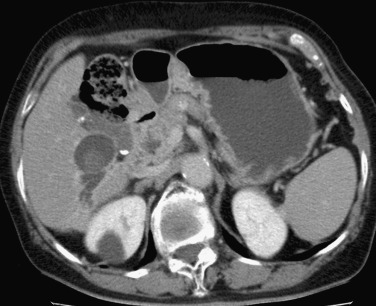
For a biliary stricture with a benign cause, the stenotic segment shows minimal wall thickening, making it difficult to see on CT or MRI ( Fig. 42-52 ). The stenotic segment is abrupt and short, measuring less than 1 cm. In contrast, for periductal-infiltrating cholangiocarcinoma, the involved bile duct wall is thicker than 2 mm and enhances intensely after contrast administration.
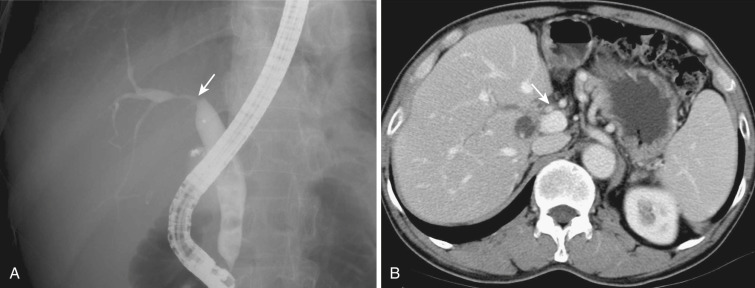
In PSC, there are multiple sites of stricture and normal or dilated segments, resulting in a beaded appearance. In recurrent pyogenic cholangitis, branching points of lobar and segmental bile ducts are the common sites of stricture; this is where the stones tend to lodge, causing irritation and inflammation at the branching points, resulting in fibrosis and stricture. Common sites are the lateral segmental bile duct of the left hepatic lobe ( Fig. 42-53 ), posterior segmental bile duct of the right hepatic lobe ( Fig. 42-54 ), and bifurcation of the right and left hepatic ducts (see Figs. 42-11 and 42-29 ).
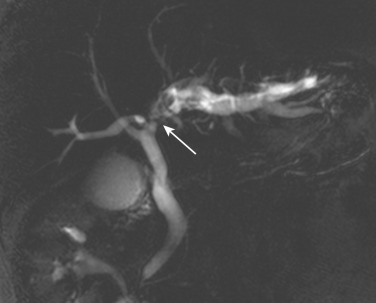
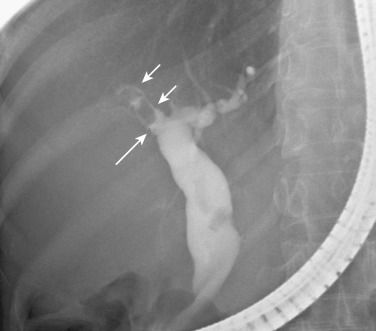
A focal stricture of the CBD occurs in approximately 0.5% of cholecystectomy patients. This complication occurs when the cystic duct is clamped and ligated and the CBD is inadvertently incorporated into the ligatures, causing injury. Clinical manifestations including jaundice may appear within a week, months, or years, depending on the severity of the bile duct damage. CT reveals severely dilated IHDs, with the degree of dilatation depending on the severity of the bile duct obstruction. At the hepatic hilum there is an abrupt transition from the dilated bile ducts to the normal extrahepatic ducts, where there is a short segmental tight stricture ( Fig. 42-55 ). A coronal reconstruction image better shows the stenotic segment. A biliary stricture caused by injury to the anastomotic site during liver transplantation typically occurs at the proximal part of the extrahepatic duct. The degree of stenosis varies from mild stenosis without bile flow impairment ( Fig. 42-56 ) to a tight stricture and complete obstruction of bile flow ( Fig. 42-57 ).
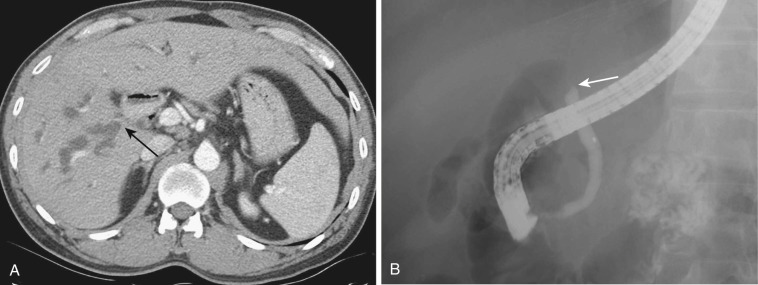
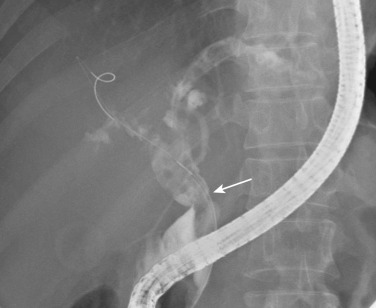
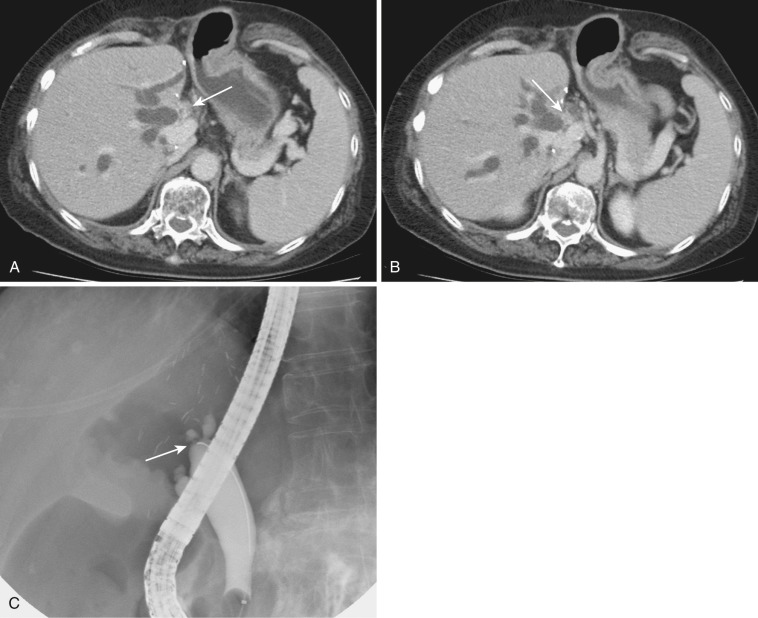
A biliary stricture caused by blunt abdominal trauma occurs in the suprapancreatic portion of the CBD. The CBD is susceptible to disruption from deceleration injuries, usually at the level of the pancreaticoduodenal junction, where it is relatively fixed compared with the more proximal duct. A delayed common duct stricture has been reported after blunt abdominal trauma. The injury results in a short segmental tight stricture with concentric or eccentric involvement and proximal dilatation.
Become a Clinical Tree membership for Full access and enjoy Unlimited articles
If you are a member. Log in here